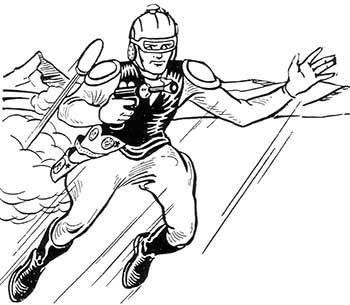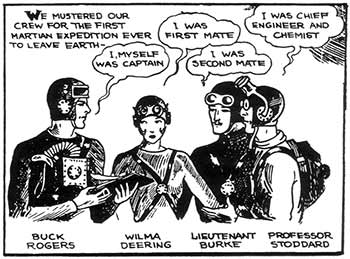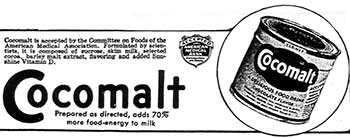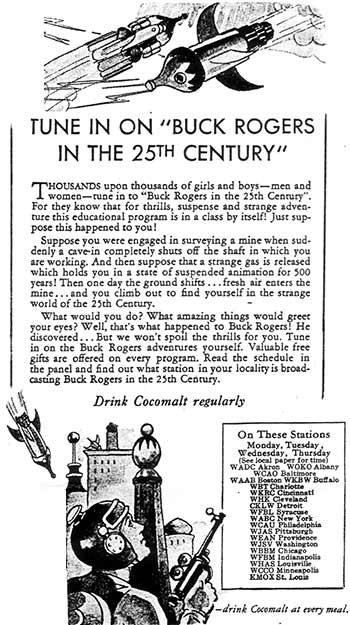|

This story was published in Radio Recall, the journal of the Metropolitan Washington Old-Time Radio Club, published six times per year.
Click here to return to the index of selected articles.
|
|
BUCK ROGERS IN THE (20th) CENTURY
by Maury Cagle, © 2004
(From Radio Recall, April 2004)
Part One --- Buck Takes Off
Few fictional characters have had such a profound and prolonged impact on American popular culture as Buck Rogers. Created in 1928, Buck was seen for 53 years in pulp magazines, daily and Sunday newspaper comic strips, comic books, Big Little Books, on radio, movie serials, a feature motion picture, and on television. All these iterations were supported by a wide variety of promotional items, some of them worth a small fortune today. On a recent day, typing "Buck Rogers" into your web browser showed 437,000 sites, while eBay listed 346 items at auction. A Cocomalt Buck Rogers premium recently brought $3700. Not bad for a character who last appeared 23 years ago.

Rogers first appeared in a short novel called "Armegeddon 2419 A.D.," written by Philip Francis Nowlan for the August 1928 Amazing Stories, now a highly-prized collector issue. At the time, he wasn't called Buck, but Anthony Rogers.
The story precisely described the bazooka, jet plane, walkie-talkie, and an infrared ray gun for night fighting, along with dozens of other advances, some just now being developed.
The editor and publisher of Amazing Stories, Hugo Gernsback, a revered pioneer promoter of science fiction (then called "scientifiction"), said of Nowlan's novella: "We prophesy that this story will become more valuable as the years go by. It certainly holds a number of interesting prophecies, many of which, no doubt, will come true."
"Armegeddon 2419 A.D." caught the eye of John Flint Dille, president of the National Newspaper Service Syndicate. He commissioned Nowland to do a science fiction comic strip---the first---illustrated by Richard Calkins. Buck Rogers in the 25th Century debuted on January 7, 1929, with "Anthony" changed to "Buck." The strip ran without interruption until 1967, and at its peak was carried by more than 400 newspapers and translated into 18 languages.
The scenario had Buck, a former fighter pilot in The Great War, surveying abandoned mines in Pennsylvania. He was trapped in a cave-in, and overcome by a strange, radioactive gas, which put him into suspended animation for 500 years. Upon awakening, the first person he sees is Wilma Deering, who becomes his copilot and shares his adventures.
The world into which Buck reawakens is dominated by Mongols. Those fighting the occupiers have gathered in a new American capital, Niagra. In no time, Buck has become a captain, a secret agent, an intelligence officer, and head of the Rocket Rangers. In addition to Wilma, his closest colleagues are the brilliant, eccentric Dr. Huer and Black Barney, a reformed Martian space pirate. For the next 38 years, Buck battled not only the Mongols, but the evil Killer Kane and his partner in crime, the malevolently beautiful Ardala.
To try to gauge the impact of the comic strip, with its rocket ships, ray guns, and robots, you have to look at America in 1929. One-third of its houses did not have electricity, and there were no really good cross-country highways. Radio was still in its infancy, and only four homes in ten had a telephone. The first streamlined train was only on the drawing boards. In many ways, America was little changed from the 1890's. Buck Rogers was truly an innovation.
Noted author Ray Bradbury, born in 1920, beautifully evokes how Buck Rogers captured the imagination in his introduction to The Collected Works of Buck Rogers in the 25th Century, which reads in part: "There you are, waiting, trembling, in fevers; so full of life that if you were a volcano you'd come up in someone's cornfield and bury the silo. There you are, as afternoon slides toward warm dusk, eyes shut, listening....
"And there's the sound, whistling through the air, crashing along the shingles, sliding down the roof, falling to the porch. You fling the door wide. You bend to touch that incredible newspaper with a hot hand. BUCK ROGERS has just been born. And you, a single wise small boy, are there alone to welcome him to a world he will help change forever."

The comic strip became an immense hit; so much so that in 1934, one Virginia department store had Buck Rogers appear at Christmas time instead of Santa Claus.
With the huge popularity of the comic strip, it was a natural for Buck Rogers to become part of the nation's latest craze, radio. "Buck Rogers In the 25th C-E-N-T-U-R-YYYYY" hit the airwaves on November 7, 1932. It was the first science fiction radio program, and one that John Dunning calls "one of the important early juvenile adventures."
There were three main series of radio shows: 1932-1936; 1939-1940; and 1946-1947. The first series was on CBS, and was sponsored by Kellogg's, Cocomalt, and Cream of Wheat. It started as a 15 minute daily show and eventually became three times a week. The second and third series were on Mutual, the last sponsored by General Foods' Popsicles.

The plots were similar to the comic strip, with Buck, Wilma and Dr. Huer saving the universe from the fiendish plots of Killer Kane and Ardala.
The sounds of death rays, incendiary missiles, gamma bombs and a mechanical mole, which thrilled listening youngsters were simulated by the sound effects crew using a variety of electrical and hand-powered utensils. For instance, the crackling buzz of the psychic destruction ray was a Schick razor. Many men no doubt felt the same effect, using their razors early in the morning.
The title role of Buck Rogers was first played by Curtis Arnall, then by Matt Crowley, Carl Frank and John Larkin. Wilma Deering was voiced by Adele Ronson and Virginia Vass. Edgar Stehli was Dr. Huer for the entire run on radio. The evil adventuress Ardala was Elaine Melchior, while Bill Shelley and Dan Ocko were the long running villain, Killer Kane. Buck's stupid but friendly sidekick Black Barney was played by Jack Roseleigh and Joe Granby.
The show was announced first by Paul Douglas, then Fred Uttal. Jack Johnstone was the Writer/Producer/Director. Other writers were Joe Cross, Albert Miller, and Dick Calkins (the original illustrator for the comic strip, who also took over the story lines for the strip when Philip Nowlan left to concentrate on writing magazine science fiction). The ambitious sound effects of the various rockets and futuristic gadgets were created by Ora Nichols.
(Part II will look at some of the Buck Rogers premiums, as well as the movie serial, two television series, and feature motion pictures.)

About the author: Maury Cagle is a long-time MWOTRC member who lives in Herndon, VA. He is a fan not only of old time radio, but most old things, collecting early science fiction and aviation books, classic jazz recordings, and drives two antique Studebakers.
|